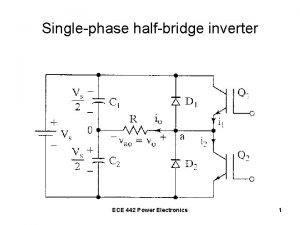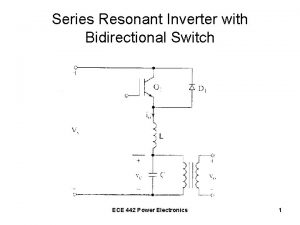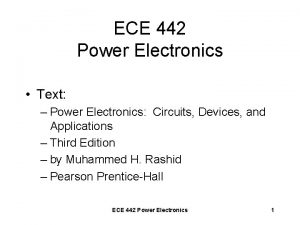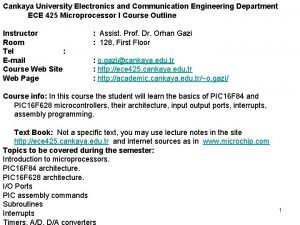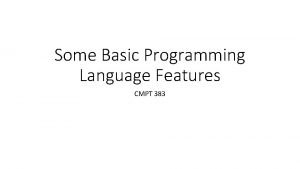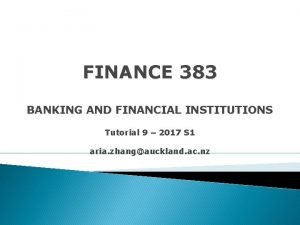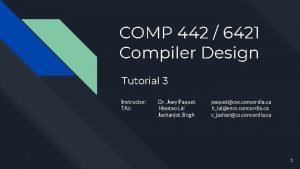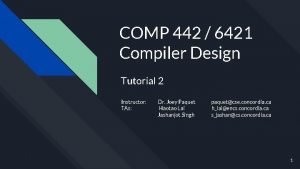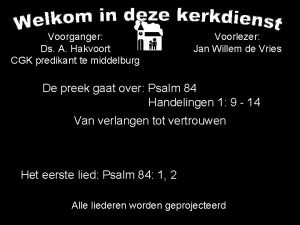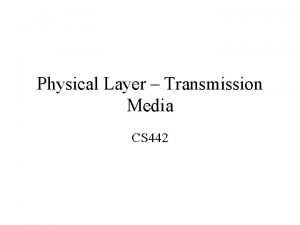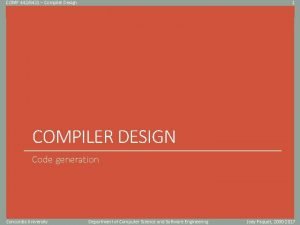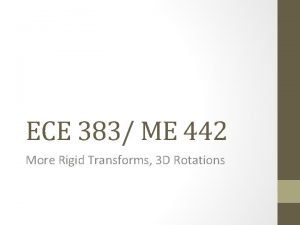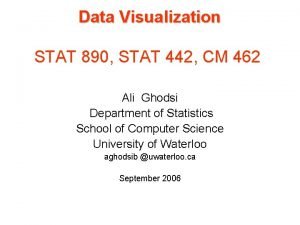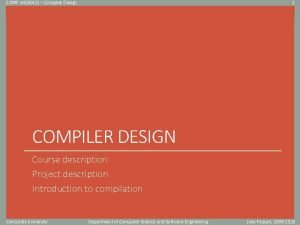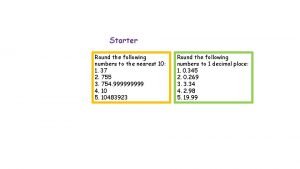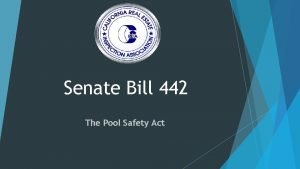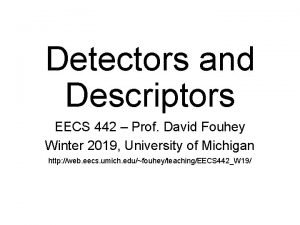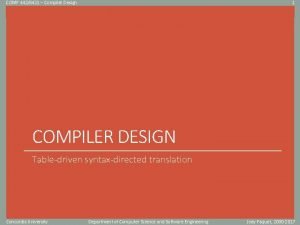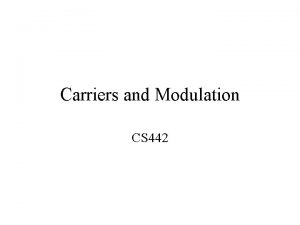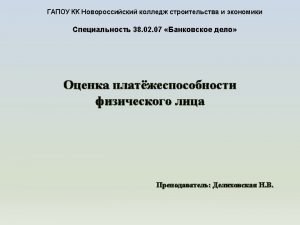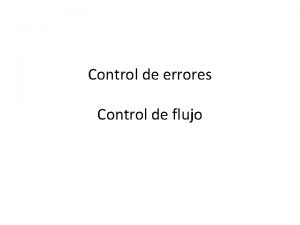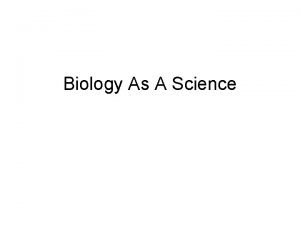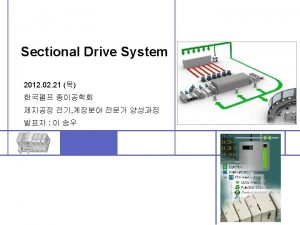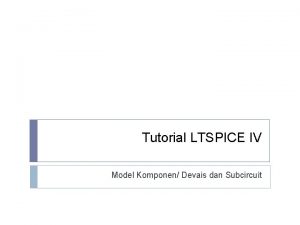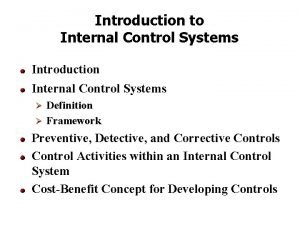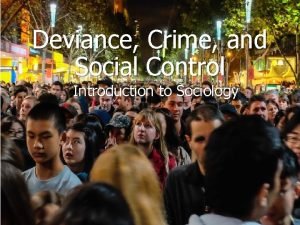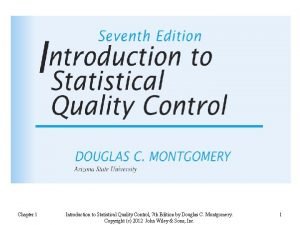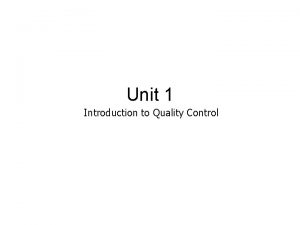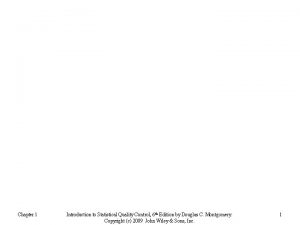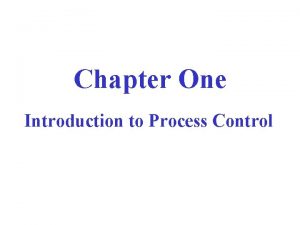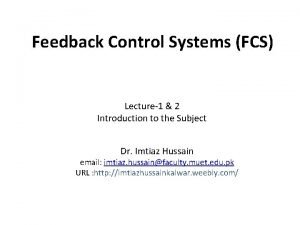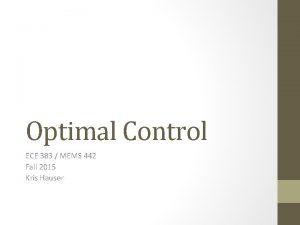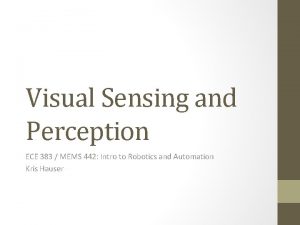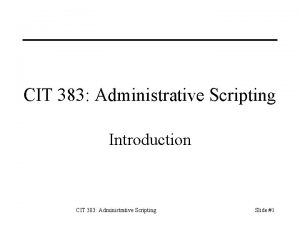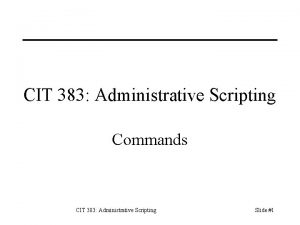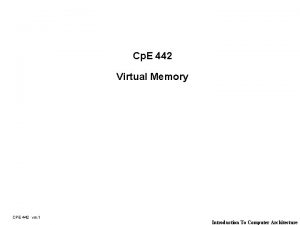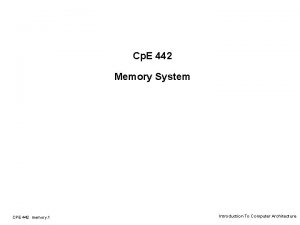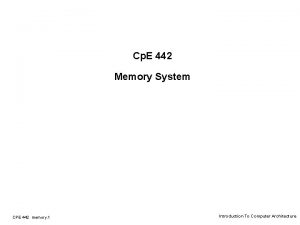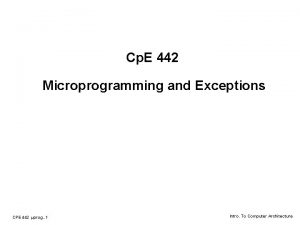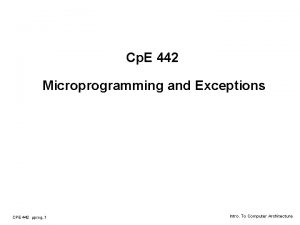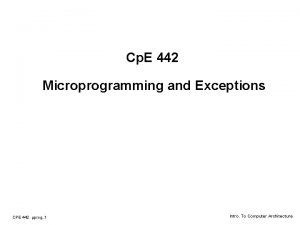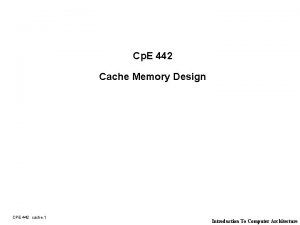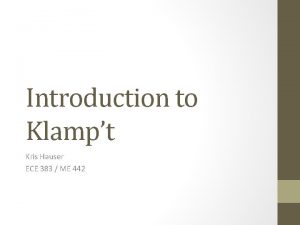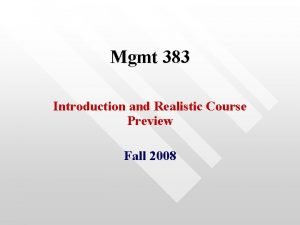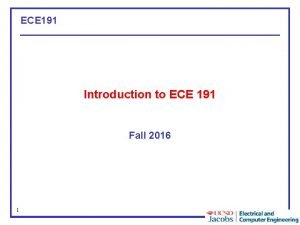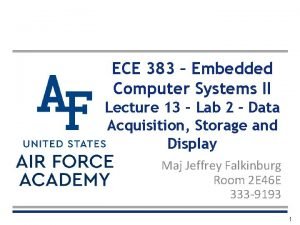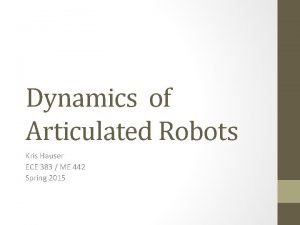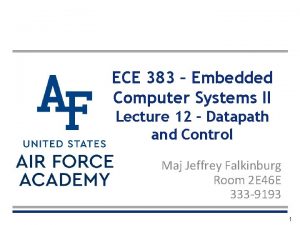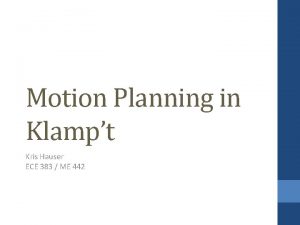Introduction to Control ECE 383 ME 442 Fall





































![Parameters: Trajectory suffix y(t): [0, T]->R Motion Queue Append trajectory Current time PID Controller Parameters: Trajectory suffix y(t): [0, T]->R Motion Queue Append trajectory Current time PID Controller](https://slidetodoc.com/presentation_image/e31c5ca08664bfccccc9d021ae993d25/image-38.jpg)

![Parameters: Insertion time tinsert Trajectory suffix y(t): [0, T]->R Motion Queue Insert trajectory Current Parameters: Insertion time tinsert Trajectory suffix y(t): [0, T]->R Motion Queue Insert trajectory Current](https://slidetodoc.com/presentation_image/e31c5ca08664bfccccc9d021ae993d25/image-40.jpg)











- Slides: 51

Introduction to Control ECE 383 / ME 442 Fall 2015 Kris Hauser

Motors •

Motors • Note: not actually the Baxter’s SEA

Underactuation • Roughly, when number of controls are fewer than degrees of freedom • More precisely, effects of controls do not span a full rank subset of the state space • Examples: car-like vehicles, legged robots, hands, Segways, UAVs • Is it even possible to perform a task? • Sometimes! • Requires carefully designing reactions to sensor data


Control Theory • The use of feedback to regulate a signal Desired signal xd Controller Control input u Signal x Plant Error e = x-xd (By convention, xd = 0) x’ = f(x, u)

What might we be interested in? • Controller engineering • Produce a policy u(x, t), given a description of the plant, that achieves “good” performance • Verifying theoretical properties • Convergence, stability, optimality of a given policy u(x, t) • System identification (system ID) • Describe the plant using a computational model, e. g. , for simulation, policy optimization, etc

Agenda • Basic feedback control • PID control • Classic linear control theory • Trajectory-following control • Note: this course uses a state space model, but traditional controls courses heavily use frequency domain model (specifically, Laplace transform) • State space is usually more appropriate for nonlinear systems

Dynamic systems •

Terminology •

Second order systems, phase space •

Example: 1 D Point Mass • Mass M p v • 2 D configuration space (state space) • Controlled force u=f • Equations of motion: dp/dt = v dv/dt = f / M

Example: 1 D Point Mass • Mass M p v • 2 D configuration space (state space) • Controlled force u=f • Equations of motion: dp/dt = v dv/dt = f / M

Example: 1 D Point Mass p v v dp/dt = dv dv/dt = f / M f=0 Solution: v(t) = v(0)+t f /M p(t) = p(0)+t v(0) + ½ t 2 f / M p

Example: 1 D Point Mass p v v dp/dt = dv dv/dt = f / M f>0 Solution: v(t) = v(0)+t f /M p(t) = p(0)+t v(0) + ½ t 2 f / M p

Example: 1 D Point Mass p v v dp/dt = dv dv/dt = f / M f<0 Solution: v(t) = v(0)+t f /M p(t) = p(0)+t v(0) + ½ t 2 f / M p

Example: 1 D Point Mass p v v dp/dt = dv dv/dt = f / M |f|<=fmax Solution: v(t) = v(0)+t f /M p(t) = p(0)+t v(0) + ½ t 2 f / M p

Toy Nonlinear Systems Cart-pole Mountain car Acrobot

“Error” • • A fact of life Sensing error Motor control noise / peculiarities Disturbances Breakages Unobservables Other intelligent agents (e. g. , human operators, humans in environment)

“Error” • • A fact of life Sensing error Motor control noise / peculiarities Disturbances Breakages Unobservables The goal of feedback control is to Other intelligent agents (e. g. , human operators, humans in choose controls that sense and environment) respond to errors in order to achieve the desired task

Model-free vs model-based • Two general philosophies: • Model-free: do not require a dynamics model to be provided • Model-based: do use a dynamics model during computation • Model-free methods: • Simpler • Tend to require much more manual tuning to perform well • Model-based methods: • Can achieve good performance (optimal w. r. t. some cost function) • Are more complicated to implement • Require reasonably good models (system-specific knowledge) • Calibration: build a model using measurements before behaving • Adaptive control: “learn” parameters of the model online from sensors

PID control • Proportional-Integral-Derivative controller • A workhorse of 1 D control systems • Model-free, myopic

Proportional term Gain • u(t) = -Kp x(t) • Negative sign assumes control acts in the same direction as x x t

Integral term Integral gain • x t Residual steady-state errors driven asymptotically to 0

Instability • For a 2 nd order system (momentum), P control Divergence x t

Derivative term Derivative gain • u(t) = -Kp x(t) – Kd x’(t) x

Putting it all together •

Controller Tuning Workflow 1. Hypothesize a control policy 2. Analyze performance: • Assume a model • Assume disturbances to be handled • Test performance either through mathematical analysis, or through simulation 3. Go back and redesign control policy • Mathematical techniques give you more insight to improve redesign, but require more thought

Parameter tuning

Example: Damped Harmonic Oscillator • Second order time invariant linear system, PID controller • x’’(t) = A x(t) + B x’(t) + C + D u(x, x’, t) • For what starting conditions, gains is this stable and convergent?

Stability and Convergence • System is stable if errors stay bounded • System is convergent if errors -> 0

Example: Damped Harmonic Oscillator • x’’ = A x + B x’ + C + D u(x, x’) • PID controller u = -Kp x –Kd x’ – Ki I • x’’ = (A-DKp) x + (B-DKd) x’ + C - D Ki I

Homogenous solution • • • Instable if A-DKp > 0 Natural frequency w 0 = sqrt(DKp-A) Damping ratio z=(DKd-B)/2 w 0 If z > 1, overdamped If z < 1, underdamped (oscillates)

Example: Trajectory following • x(t) xdes(t) x(t)

Motion Queue Motion queue controllers Current time PID Controller Torque Robot

Motion Queue Motion queue controllers Current time PID Controller Torque Robot

Motion Queue Motion queue controllers Current time PID Controller Torque Robot
![Parameters Trajectory suffix yt 0 TR Motion Queue Append trajectory Current time PID Controller Parameters: Trajectory suffix y(t): [0, T]->R Motion Queue Append trajectory Current time PID Controller](https://slidetodoc.com/presentation_image/e31c5ca08664bfccccc9d021ae993d25/image-38.jpg)
Parameters: Trajectory suffix y(t): [0, T]->R Motion Queue Append trajectory Current time PID Controller Torque Robot

Motion Queue Current time PID Controller Torque Robot
![Parameters Insertion time tinsert Trajectory suffix yt 0 TR Motion Queue Insert trajectory Current Parameters: Insertion time tinsert Trajectory suffix y(t): [0, T]->R Motion Queue Insert trajectory Current](https://slidetodoc.com/presentation_image/e31c5ca08664bfccccc9d021ae993d25/image-40.jpg)
Parameters: Insertion time tinsert Trajectory suffix y(t): [0, T]->R Motion Queue Insert trajectory Current time PID Controller Torque Robot

Motion Queue Current time PID Controller Torque Robot

Multivariate Systems • • x’ = f(x, u) x X Rn u U Rm Because m n, and variables are coupled, this is not as easy as setting n PID controllers

Linear Time-Invariant Systems • Linear: x’ = f(x, u, t) = A(t)x + B(t)u • LTI: x’ = f(x, u) = Ax + Bu • Nonlinear systems can sometimes be approximated by linearization

Convergence of LTI systems • x’ = A x + B u • Let u = - K x • Then x’ = (A-BK) x • The eigenvalues li of (A-BK) determine convergence • Each li may be complex • Must have real component between (-∞, 0]

Feedforward control • If we know a model for a system and know how it should move, why don’t we just compute the correct control? • Ex: damped harmonic oscillator • • x’’ = A x + B x’ + C + D u Calculate a trajectory x(t) leading to x(T)=0 at some point T Compute its 1 st and 2 nd derivatives x’(t), x’’(t) Solve for u(t) = 1/D*(x’’(t) - A x(t) + B x’(t) + C) • Would be perfect!

Feedforward control • If we know a model for a system and know how it should move, why don’t we just compute the correct control? • Ex: damped harmonic oscillator • • x’’ = A x + B x’ + C + D u Calculate a trajectory x(t) leading to x(T)=0 at some point T Compute its 1 st and 2 nd derivatives x’(t), x’’(t) Solve for u(t) = 1/D*(x’’(t) - A x(t) + B x’(t) + C) • Problems • Control limits: trajectory must be planned with knowledge of control constraints • Disturbances and modeling errors: open loop control leads to errors not converging to 0

Handling errors: feedforward + feedback • Idea: combine feedforward control uff with feedback control ufb • e. g. , ufb computed with PID control • Feedback term doesn’t have to “work” as hard (= 0 ideally) x(0) Feedforward calculation uff + u ufb xdes Plant Feedback controller x(t)

Application: Feedforward control • Feedback control: let torques be a function of the current error between actual and desired configuration • Problem: heavy arms require strong torques, requiring a stiff system • Stiff systems become unstable relatively quickly

Application: Feedforward control • Solution: include feedforward torques to reduce reliance on feedback • Estimate the torques that would compensate for gravity and achieve desired accelerations (inverse dynamics), send those torques to the motors

Handling errors: feedforward + feedback • Idea: combine feedforward control uff with feedback control ufb • e. g. , ufb computed with PID control • Feedback term doesn’t have to “work” as hard (= 0 ideally) x(0) Feedforward calculation uff + u ufb Model based xdes Model free Plant Feedback controller x(t)

Next class: Klamp’t simulation and control • Reading: • Klamp’t simulation tutorial
 Ece 442
Ece 442 Series resonant inverter with bidirectional switches
Series resonant inverter with bidirectional switches Power electronics
Power electronics Ece 442
Ece 442 Ece 442 çankaya
Ece 442 çankaya Ece 442
Ece 442 Cmpt383
Cmpt383 Ieee 383
Ieee 383 Finance 383
Finance 383 Eecs 442
Eecs 442 Compiler design tutorial
Compiler design tutorial Compiler design tutorials
Compiler design tutorials Psalm 84 liedboek
Psalm 84 liedboek Velocity of propagation cable chart
Velocity of propagation cable chart Ee 442
Ee 442 Comp 442
Comp 442 Controlece
Controlece Me 442
Me 442 Me 442
Me 442 Stat 442
Stat 442 Comp 442
Comp 442 Round the number 755 to the nearest 10
Round the number 755 to the nearest 10 Smart table 442i
Smart table 442i California swimming pool safety act 1998
California swimming pool safety act 1998 Eecs 442
Eecs 442 Comp 442
Comp 442 Cs 442
Cs 442 Umich eecs 442
Umich eecs 442 Eecs 442
Eecs 442 Translational research institute on pain in later life
Translational research institute on pain in later life Product inspection vs process control
Product inspection vs process control Reynolds transport theorem
Reynolds transport theorem Stock control e flow control
Stock control e flow control Control volume vs control surface
Control volume vs control surface Negative control
Negative control Positive control vs negative control
Positive control vs negative control Jelaskan tentang error control pada data link control?
Jelaskan tentang error control pada data link control? Control de errores
Control de errores Negative control vs positive control examples
Negative control vs positive control examples Flow and error control
Flow and error control Sectional drive
Sectional drive Salin teks di foto
Salin teks di foto Introduction to internal control
Introduction to internal control Labelling theory
Labelling theory Introduction to statistical quality control
Introduction to statistical quality control Introduction to quality control
Introduction to quality control Difference between internal check and internal control
Difference between internal check and internal control Digital control
Digital control Introduction to digital control system
Introduction to digital control system Introduction to statistical quality control
Introduction to statistical quality control Introduction to process control
Introduction to process control Fcs control systems
Fcs control systems
